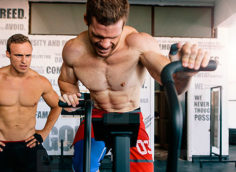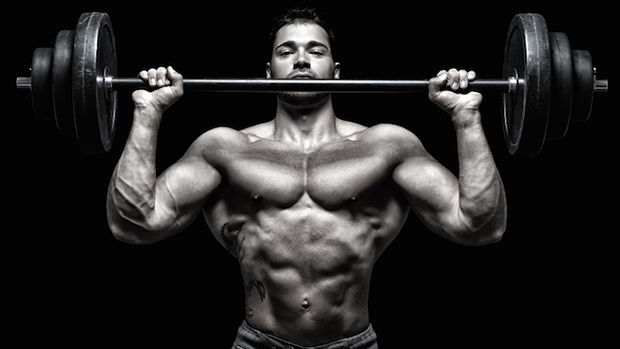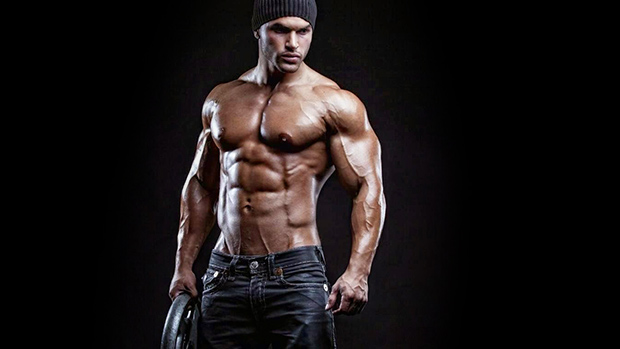I'm a raw beginner and hyped to try 5/3/1. Should I make any changes in frequency, volume, etc.?
Generally, I tell everyone to just do the program as is, regardless of training age.
Of course, if you're a trainer and are using the program with a novice athlete or someone new to training, simply use your experience to make whatever changes are required – though there shouldn't be many.
Now if you're a beginner and are working out without any guidance whatsoever, it's probably best to just stick with the basic program. One of the worst things a young lifter can do is take advice from other beginners on message boards – they usually have all the advice and none of the experience.
Below is one beginner modification that's permissible, and effective. It's a subtle, easy way to add in some extra work on the main lifts without compromising the program or the philosophies it was built upon.
You perform a full-body routine, three days a week. Full body strength routines are the best way for novice lifters to quickly get strong, provided the program is non-retarded (i.e. adheres to an intelligent progression system).
Instead of just one main lift per workout (using the 5/3/1 set-up), two main lifts are used for additional weekly exposures. The second main lift, however, should not be performed 5/3/1 style; instead, use a standard 3 sets of 5 reps, starting at 55% of your training 1RM for the first set of 5 and increasing the weight by 10% each successive set.
The exception is the deadlifting day with presses as the second lift. Just do 5/3/1 here across the board.

Monday
Squat: 5/3/1 sets/reps
Bench: 55% x 5, 65 x 5%, 75% x 5
Assistance work
Wednesday
Deadlift: 5/3/1 sets/reps
Press: 5/3/1 sets/reps
Assistance work
Friday
Bench: 5/3/1 sets/reps
Squat: 55% x 5, 65% x 5, 75% x 5
Assistance work
The program is set up the same way – taking 90% of your max and working up slowly. All percentages are based on that training max.
The first thing I'll be asked is, "What do I do for assistance work?" Because you're doing a full body routine each day and using compound lifts, you need to keep the assistance work to a minimum. Chins, dips, back raises, neck work, and curls will serve you well. Stick with that.
The above program is nothing revolutionary, but it's effective. When you're given a training max and the exact percentages to use every workout, it removes all doubt as to what's heavy, medium, or light. This is simple and easy to use for any beginner.
Intermediate lifters, provided the percentages on the non-5/3/1 days are lowered by 10 percent each set, can also use this basic structure. (As you get more experienced, you can't handle the extra work at a heavier percentage.)
What are some easy and basic ways to improve grip strength?

One thing that became a huge problem for me during the last few years I competed in powerlifting (not counting the raw meet I did last July) was my grip strength. I never had a problem with my grip before but as the years wore on, my grip slowly got worse. Looking back, I think I figured out some of the things that I did wrong.
Here's the top five mistakes I made that resulted in my grip getting weaker:
- Not doing reps on pulling exercises, specifically deadlifts and cleans. This one change is the easiest and best way to actually get stronger and make progress in your grip (and your deadlift). As soon as I fell for the "singles build strength myth," my grip was 100% sewer filth. Do some reps and build some strength.
- Do rope/towel chins. I started doing towel chins in college and this made a huge difference in my pulling strength, grip, and overall strength. To do a towel chin, simply drape two towels over a chin bar, bring the ends together, and twist them. Some people also tape up the ends with athletic tape to give them a place to put the hands. From there, just hang on and pull up. Simple, yes, but not easy to do – especially if your grip is awful and your bodyweight is 3-oh-Fat.
- Kroc rows. This has been explained countless times, but if your grip strength sucks, do Kroc rows as your second exercise. A Kroc row is nothing more than a high rep, one-arm dumbbell row. Begin with one warm-up set of 10 reps with an easy weight. After that, pick the heaviest weight you can do for 20-50 reps and blast away. Make sure to do both arms. (I suppose that goes without saying but you never know.) Kroc rows will make your grip awesome as well as train your upper back and lats to a great degree.
- Do your "boring but big" assistance sets with an overhand grip. This modification may limit the amount of weight you can do initially, but your grip will get stronger and adapt.
- Lose weight. I don't have the biggest hands in the world but when I got bigger, my palms turned into paws and my fingers became sausages. This killed my grip strength. So if you have small hands and things jiggle when you even THINK about jogging, you're fat. Lose some fat and get stronger. Your grip – and the mirror – will thank you.
I'm a bit of a gear guy. What kind of training gear/clothing do you think is essential?
Clothing-wise, wear whatever you think is comfortable to train in. I generally wear cutoff cargo pants and whatever T-shirt/long sleeve shirt I have on that day. I'm not too specific, only that I abhor typical training shorts – mesh or otherwise. That's just my personal preference and whatever yours is, adhere to it!
As for gear, the two biggest things that people need (other than gym equipment) are a belt and a good pair of squat shoes. Don't skimp on either of these things; they may be expensive but they'll last a lifetime. The belt I use is a typical powerlifting belt – 4 inches wide and only 10 mm thick; I don't particularly like a super stiff belt. I don't want to spend a year breaking it in before being able to tighten or loosen the belt.
Also, always get a single prong belt as there's no need to have two prongs – it's just one more thing to fuss with. And it makes no difference in the strength of the belt. Lots of huge, strong men have lifted massive weights with a single prong belt.
As for shoes, I'm entirely convinced that Olympic lifting shoes are the way to go for squatting. Your feet don't squish around, the heel is elevated to provide great squatting position, and once you walk the weight out your feet are cemented to the ground. For deadlifting, I use the Metal Squat shoe. This is a flat-soled shoe that doesn't move around like a Chuck Taylor.
All of this stuff is expensive, but I'd rather buy nice than buy twice.
Coaches say when your personal life gets shitty, you should train, train, and train. Easier said than done. What are your thoughts on this and what do you do when your personal life interferes with your training?
I think we've all been in situations that completely drain you emotionally, physically, and mentally. It could be from school, death, divorce, money woes, or significant other stress. What I've always done is make sure lifting remains a huge part of my life, even if just for the soul-soothing regularity of being somewhere and doing something that I can control.
One important lesson that I've learned is when things get out of hand in life, keep the things that you can control, controlled. This keeps you from going insane.
The other thing that I've always done, especially during hectic times, is to always prioritize the main lifts and nothing else. So during the football season, I'd just make sure to squat, bench, and clean. I'd be exhausted but I'd pick one lift a day, set a goal, and reach it.
This is something that I still do when life starts to run me ragged, and it allows me to completely focus on what's important. The fact that I know going in that it will only demand SOME of my time is half the motivation; looking at some of the workout programs people send me, complete with 9 exercises per day, I'd never enter the weight room from the sheer amount of anticipated boredom. I want to lift heavy, not fart around.
So it comes down to this, when the world is handing you a huge pile of shit, keep the things that you enjoy in your life and keep the motivation high by not overwhelming yourself. Reach goals each workout and move on. This success will help your attitude and keep you from falling too hard.
What are some of the differences you've noticed between shirt and raw benching?

There are the obvious ones, such as the bar touching lower when wearing a bench shirt (way lower!) and the slower rate of descent with a shirt (unless you believe in the myth of tempo training).
There are a few other things that I think people tend to overlook:
Raw bench = Upper back; Shirt bench = Lats. Please understand that both the lats and upper back are used in both benches, but because of where the bar starts and is lowered, the lats and upper back are emphasized differently in each lift.
With a shirt bench, the bar begins far out over the chest/stomach area. The lats need to be held very tight to keep the bar path strong and correct. With a raw bench, the bar is lowered much higher, thus the upper back is taking much of the weight. That's why raw benching is cooler – it gives you a good excuse to do a ton of upper back and trap work.
Grip width. In general, benching with a shirt allows a wider grip (legal maximum width) to be used without any danger of injury. When benching sans shirt, the grip should come in to ensure shoulder and pectoral health.
Strength curve. When benching with a shirt, you need a VERY strong lockout as the bench shirt changes the strength curve of the lift. With a raw bench, you need to be very strong off the chest and in the middle portion of the lift. Now don't get me wrong – both lifters need both portions to be strong, but there's a big difference when the strength curve is changed.
When in doubt, just get really, really strong. It tends to cure most problems in training – and life.





